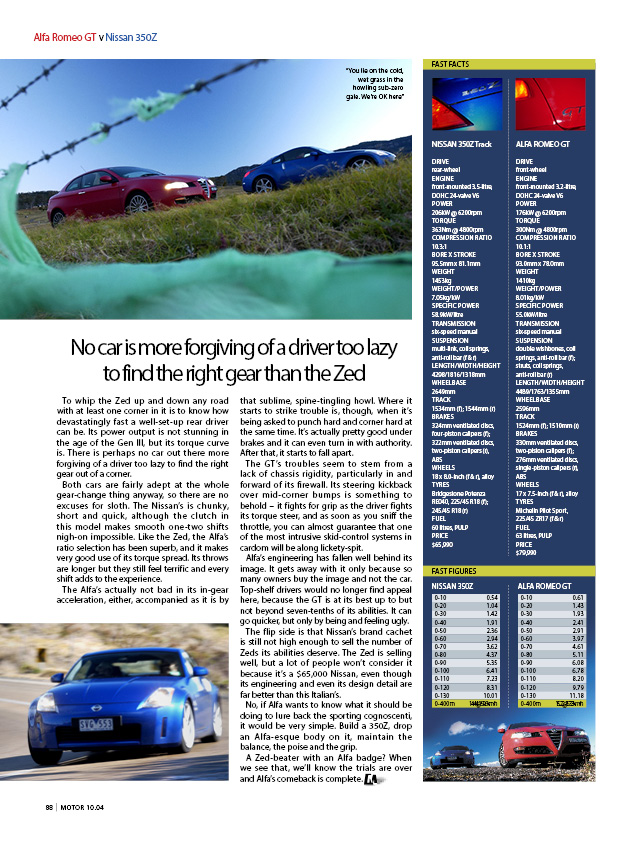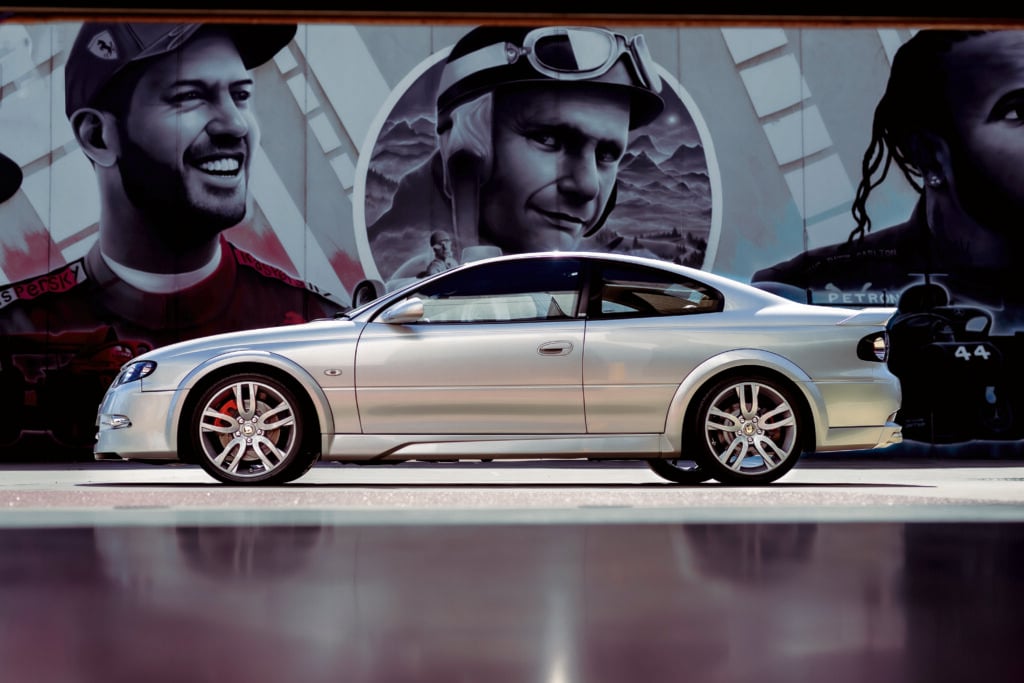You’ve got to hand it to Alfa Romeo’s legionnaires, haven’t you? They just keep trying, even though they’ve been through deeper trials than the Das Boot crew. And, through all their attempts at self-sabotage, they’ve somehow kept something of a prestige sporty image out in punterland.
This feature was first published in MOTOR magazine’s October 2004 issue
If the Italian management wants to recover and consistently get it right, one company it could take its inspiration from is Nissan. A moribund hulk three years ago, it’s been turned around so spectacularly that it’s kicking the butts of all comers in Japan.
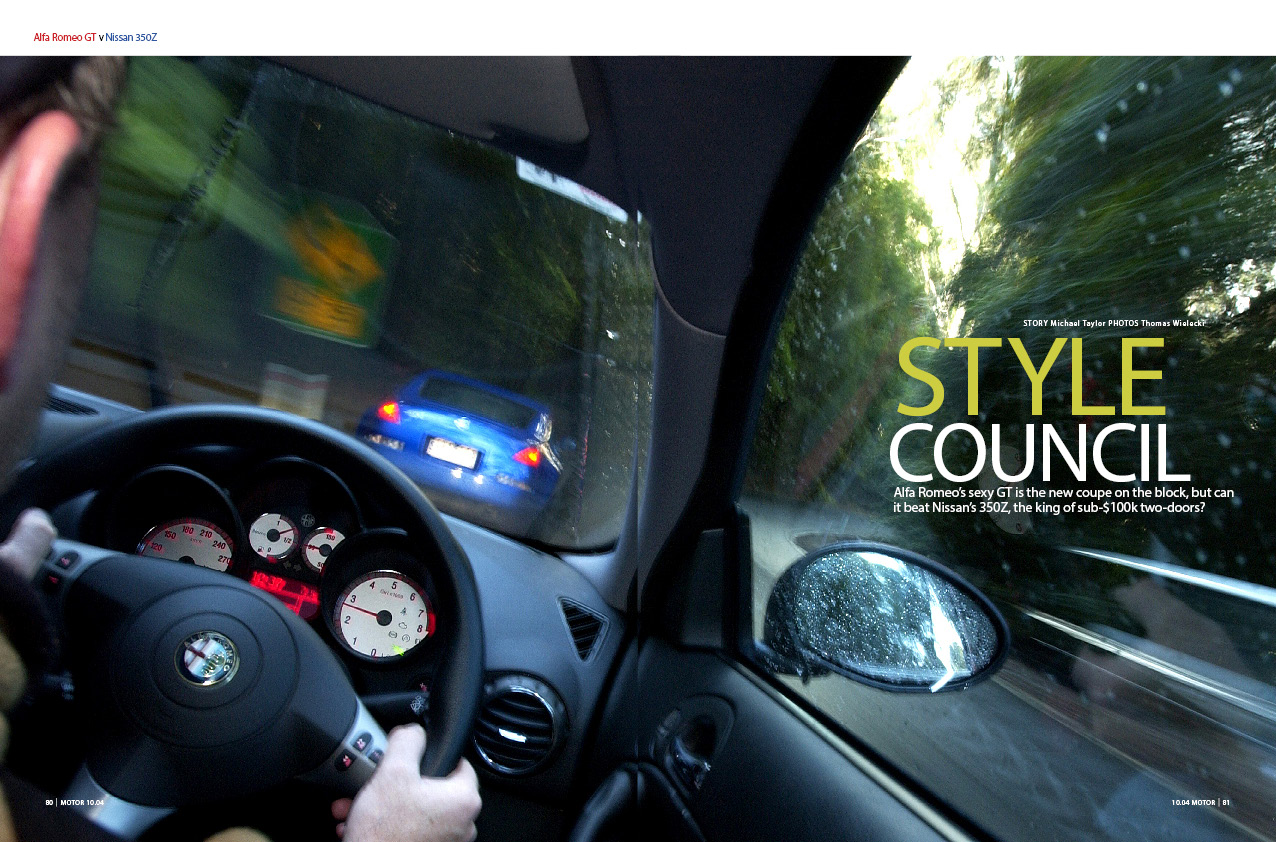
That’s if they get it right. A stop-gap Alfa’s new GT may be, but it’s still got to fight the grown-ups and, if Alfa is going to insist on proclaiming the model’s sportiness, Nissan’s got just the machine to challenge it.
It’s been seen in these pages before (yep, this very jigger, actually), and we’ve determined that the 350Z is quite possibly the best sub-$100k two-door coupe doing the rounds at the moment. And it’s also gobbled up its main fellow contenders – Mazda’s torque-free RX-8 and Holden’s mass-production-based Monaro – with relative ease.
In our books, any two-door that wants to stake a sporting claim on this side of the big-money wall had better be ready to stare it down and then outperform it, and that includes Alfa Romeo.

But it ain’t that simple, because there are significant philosophical differences here. Where the Nissan is a focused, two-seat, bugger-the-bumps-we’re-attacking rear-driver, the Italian isn’t. Like most recent Alfas, it’s a bum-dragger, which doesn’t automatically mean that as such it can’t be as hard-edged as a rear-driver – it just means its boffins have to look harder and make diff, spring and roll-bar choices that can compromise day-to-day comfort. Which usually means it’s a marketing decision, not an engineering one.
The biggest difference, though, is that it has rear seats that are actually usable for short-to-medium distances. It’s the first hint that the Alfa’s from a softer breed of cattle.
The second hint is that while it runs essentially the same 3.2-litre V6 engine as its overpowered 147 GTA sibling, it’s at the same 176kW spec as the ageing GTV. Already, it’s giving away 30kW to its Japanese rival.
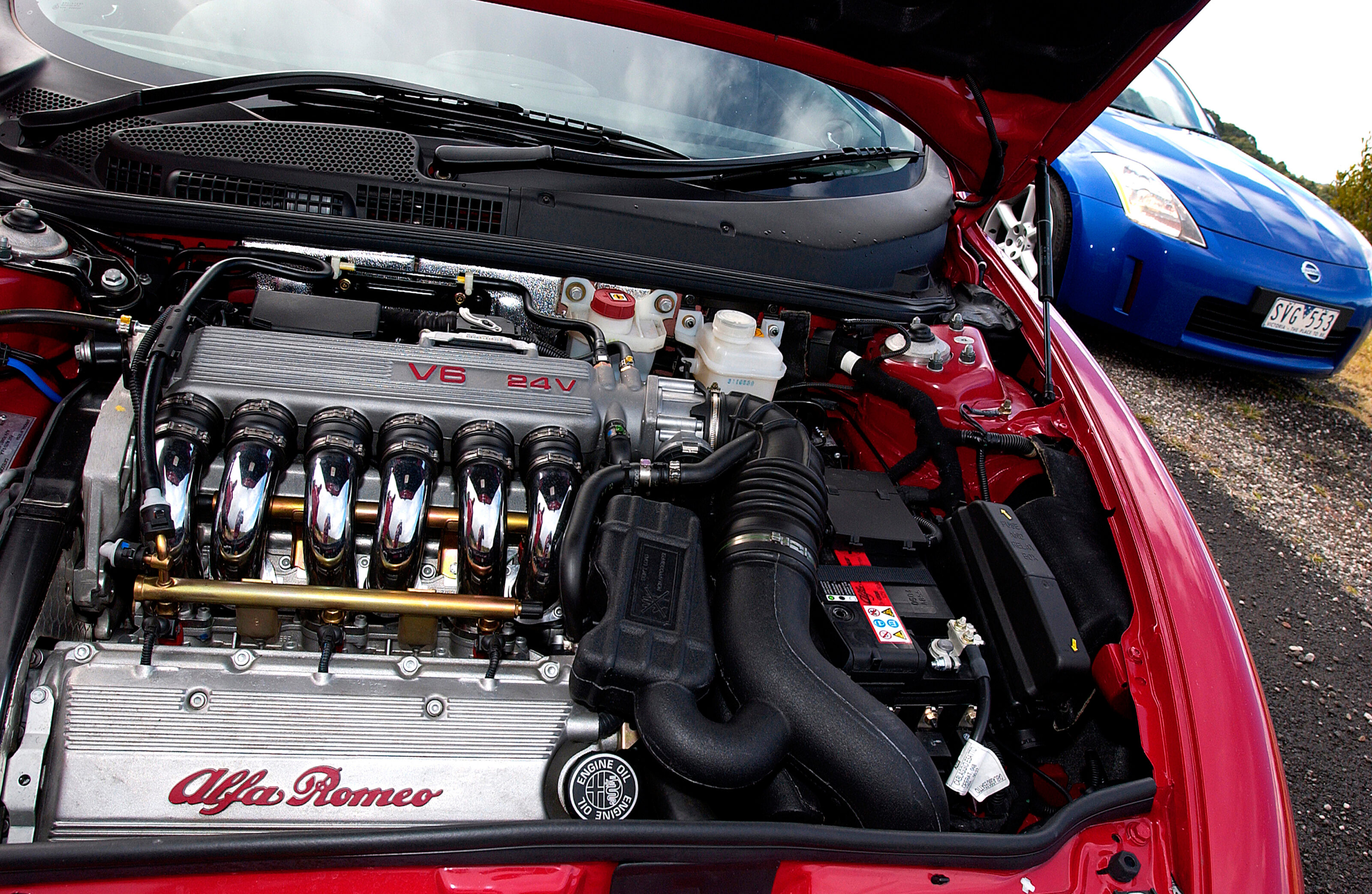
The Alfa’s go is torque, though, which it proves in the mid-range where it punches out 300Nm at a fairly high 4800rpm, even though it’s got plenty on tap from under 2000.
Still, the Zed sees the Alfa’s 300Nm and raises it 63, peaking at precisely the same engine speed. And they’re not far from each other on the scales, either. At around 1400kg apiece, neither car deserves to be sent to Ms Craig – which especially enhances the Alfa’s credibility on account of the weight of its lavish extra seats and their accompanying folding and harnessing mechanisms.
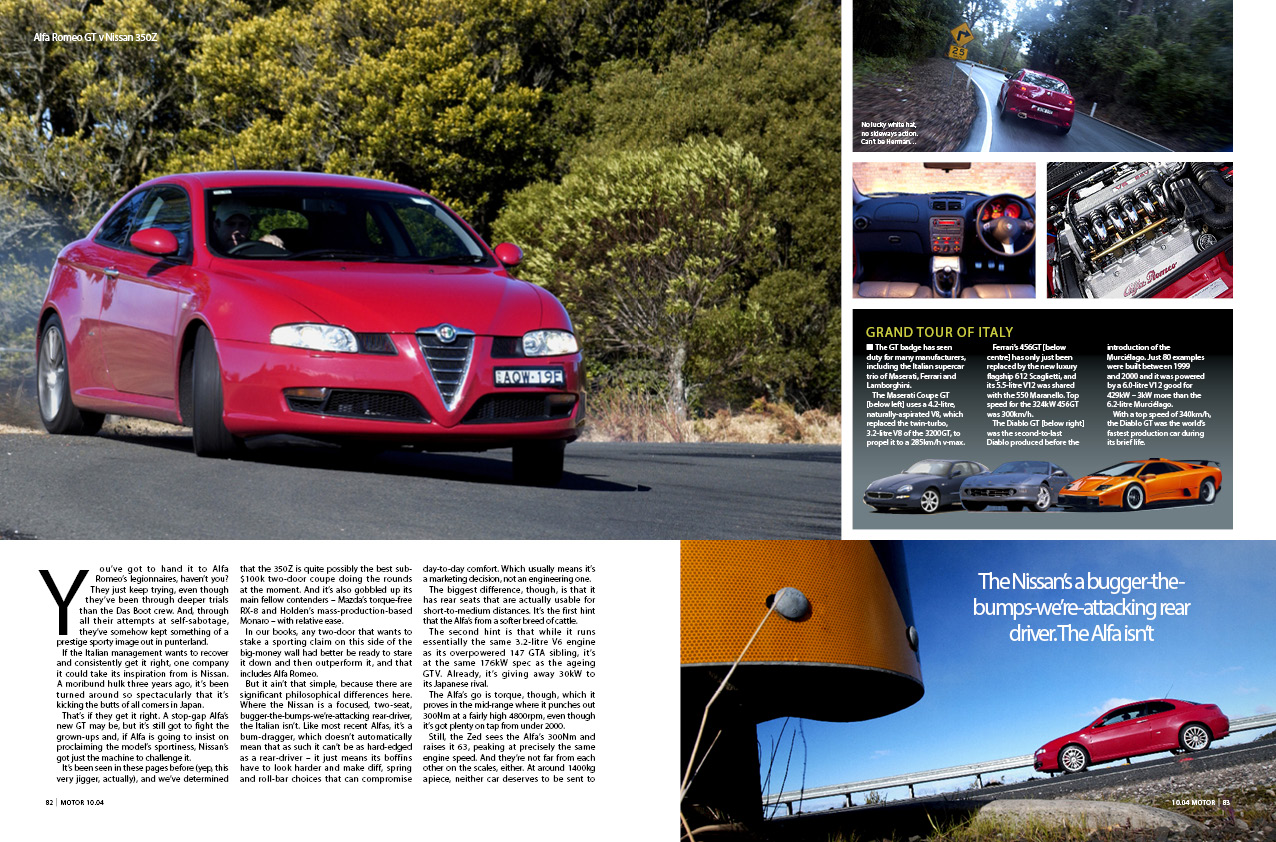
It’s a lovely interior, this Italian piece of style. Take the body for what it’s worth (some love it universally, some like it from certain angles, whilst some think they just lost interest when they got to the C-pillar), but the interior is, indeed, swish.
In an era of German-driven simplicity, expensive materials and uniform ergonomics, the Alfa is style personified. It’s the car’s highlight, even if it does leave some minor controls (cruise control, instrument lighting) bafflingly hidden behind steering wheel spokes. The dash facia is dominated by a pair of 1970s-Alfa-inspired instrument tubes, split by a more conventional fuel and temperature display, along with a space for the trip computer’s musings.
Look a bit closer, and you’ll find its centre dash a mix of good and bad, but never ugly. The sound system is the bad. Everything’s fiddly and small, and if you’re fingers are pudgier than a pencil, forget about it.
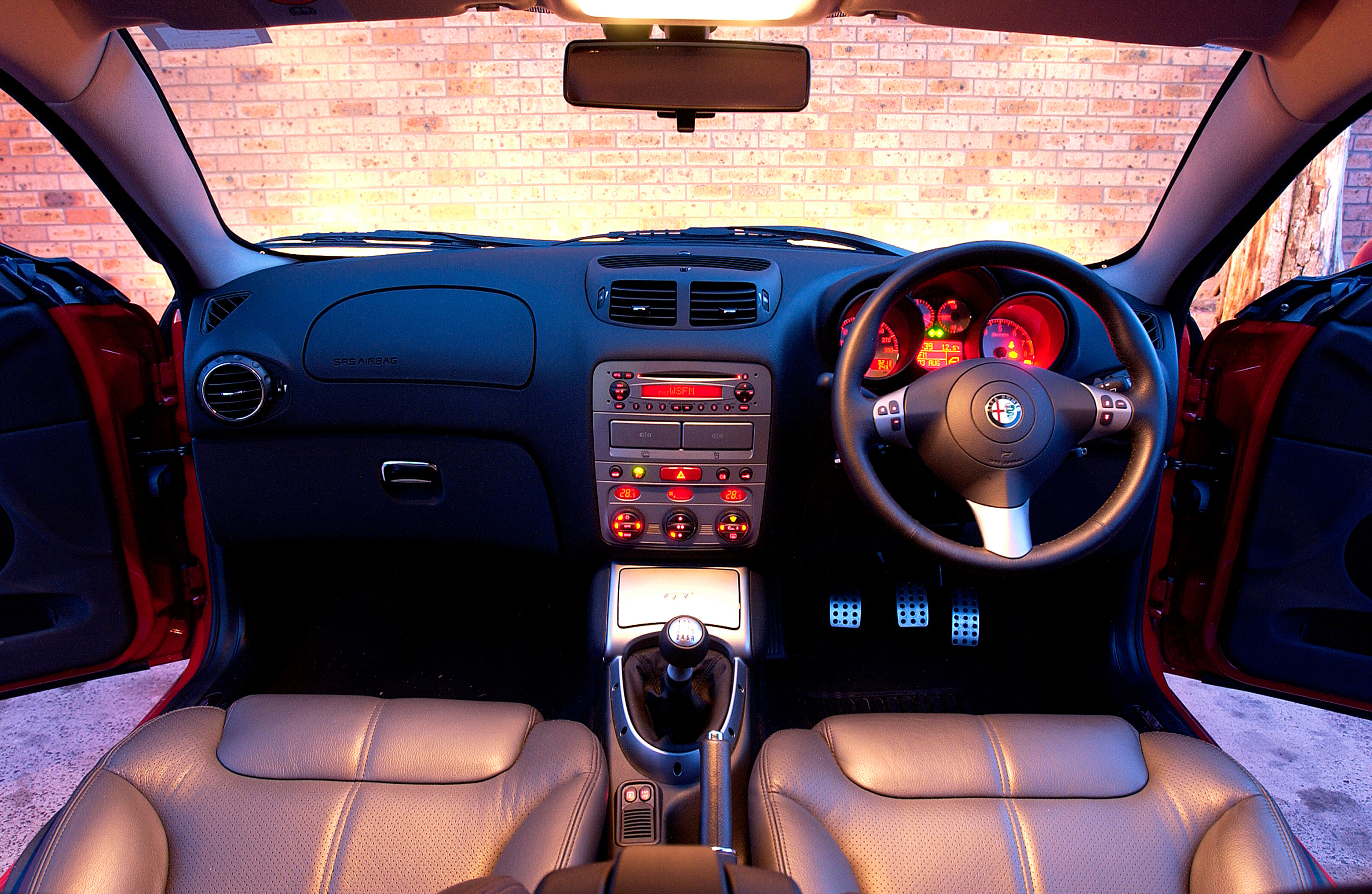
While its HVAC controls look and work a treat, it pinches the air vents straight out of the Audi TT’s design handbook but the industrial-era look doesn’t quite work with the Latin style of the rest of the dash.
Both cars have console bins, but the Zed’s is bigger. It needs to be, because there aren’t many alternatives. Its Italian rival actually has a glovebox. Not a big glovebox, perhaps, but it’s a step up from the Zed, which relies on a couple of cubby holes in its rear bulkhead to provide most of its interior storage.
At different times, we’ve bunged everything from two sets of golf clubs, a mountain bike and three weeks’ worth of holiday gear into the Zed’s rump, so we’ve gained new respect for its storage ability. It’s just that, with fold-down rear seats, the Alfa swallows more.
You probably realise we wouldn’t normally go on about an interior package, but there’s a point, and it is that in the Alfa’s case, you’re really selling it short if you don’t. In fact, to get what the GT is all about, it’s absolutely compulsory. If you were to compare the two cars purely on their abilities to whip through a mountain pass, there’d be no way you’d understand it, because, to be frank, in this company, the GT gets absolutely snotted. In-gear acceleration, straight-line sprinting, braking prowess, brake feel, turn-in ability, composure mid-corner, power-down on the way out… you name it, they’re all big ticks in the Zed’s box. Which we’ve become accustomed to seeing in comparos, to be honest.
Try as it might, the best things about the Alfa are its peripheral effects. The engine noise, for one, wouldn’t suffer in comparison with anything this side of $100k. At 1500 revs, it starts a deep melody that constantly changes in both timbre and tone as it slides towards the redline. And it’s a glorious piece of sculpture to look at, all chromed pipes and proud cam covers.
But it just doesn’t go as hard as the Zed’s bigger, 3.5-litre engine, and its shortfall in wattage can not be picked up by sound alone, and certainly not when its weight is 1410kg and the Zed’s is 1453kg in its Track spec.
Alfa claims a 0-100km/h of 6.3 seconds for the GT. Our version was half a second slower than that, and there’s not a skerrick more pace in it. It’s also in the low-15-second bracket for the quarter mile – or nearly a full second slower than the Zed.
But the impressive thing is the manner of Zed’s dominance. Ripping the tripe out of it in isolation can start you on highlighting areas where it could be better. We’d like a bit more reward for our efforts when we attack the redline, for example – in the elimination of that trace of kickback when you hit mid-corner bumps at about the same time that you run out of grip.
Drive it next to something that, outwardly, feels like an honest, stable, swift-ish machine, and you suddenly appreciate that you’ve been a bit harsh and that all that time, it’s been operating at the outer edges of a much larger envelope than we’d thought – and that we’ve been taking it for granted.
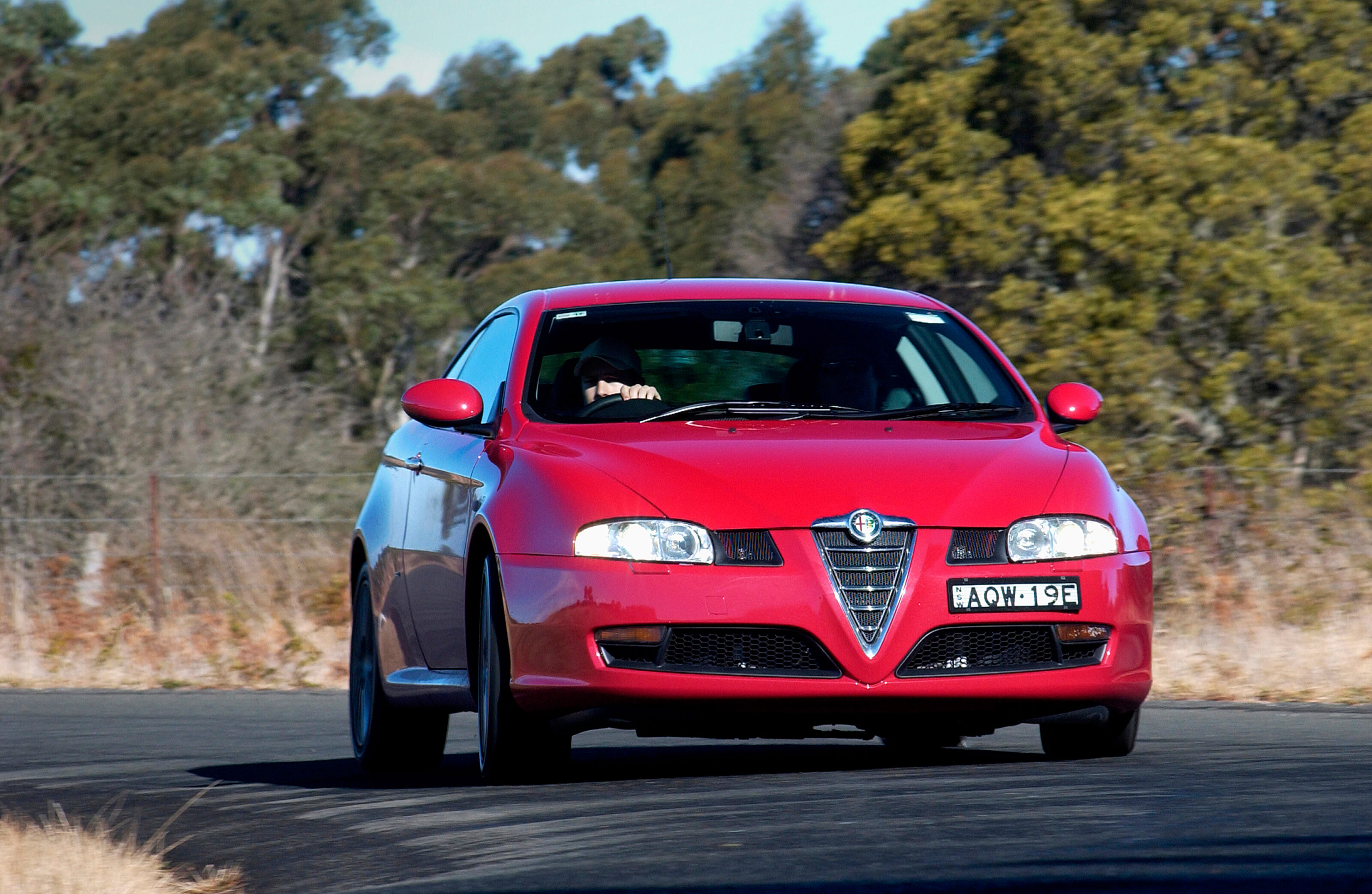
To whip the Zed up and down any road with at least one corner in it is to know how devastatingly fast a well-set-up rear driver can be. Its power output is not stunning in the age of the Gen III, but its torque curve is. There is perhaps no car out there more forgiving of a driver too lazy to find the right gear out of a corner.
Both cars are fairly adept at the whole gear-change thing anyway, so there are no excuses for sloth. The Nissan’s is chunky, short and quick, although the clutch in this model makes smooth one-two shifts nigh-on impossible. Like the Zed, the Alfa’s ratio selection has been superb, and it makes very good use of its torque spread. Its throws are longer but they still feel terrific and every shift adds to the experience.
The Alfa’s actually not bad in its in-gear acceleration, either, accompanied as it is by that sublime, spine-tingling howl. Where it starts to strike trouble is, though, when it’s being asked to punch hard and corner hard at the same time. It’s actually pretty good under brakes and it can even turn in with authority. After that, it starts to fall apart.

The GT’s troubles seem to stem from a lack of chassis rigidity, particularly in and forward of its firewall. Its steering kickback over mid-corner bumps is something to behold – it fights for grip as the driver fights its torque steer, and as soon as you sniff the throttle, you can almost guarantee that one of the most intrusive skid-control systems in cardom will be along lickety-spit.
Alfa’s engineering has fallen well behind its image. It gets away with it only because so many owners buy the image and not the car. Top-shelf drivers would no longer find appeal here, because the GT is at its best up to but not beyond seven-tenths of its abilities. It can go quicker, but only by being and feeling ugly.
The flip side is that Nissan’s brand cachet is still not high enough to sell the number of Zeds its abilities deserve. The Zed is selling well, but a lot of people won’t consider it because it’s a $65,000 Nissan, even though its engineering and even its design detail are far better than this Italian’s.

No, if Alfa wants to know what it should be doing to lure back the sporting cognoscenti, it would be very simple. Build a 350Z, drop an Alfa-esque body on it, maintain the balance, the poise and the grip.
A Zed-beater with an Alfa badge? When we see that, we’ll know the trials are over and Alfa’s comeback is complete.
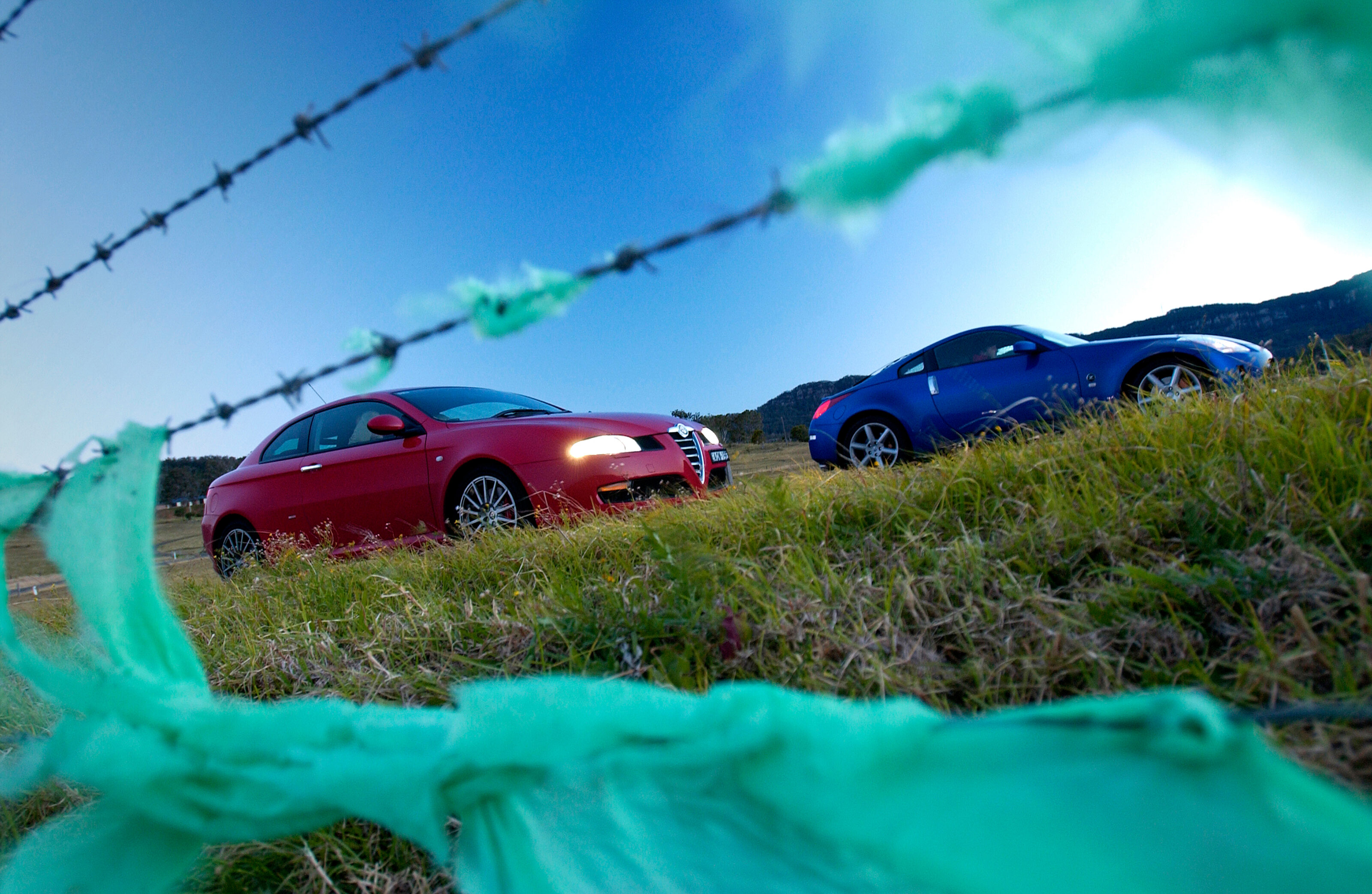
…Or you could have
Don’t want a Zed, but like the idea of a sub-$100k coupe? There’s a bit to choose from and it’s all fairly interesting. And here’s the pick of ’em.
The only real dedicated two-seat rival is Audi’s design icon, the TT. Due for replacement in 2006, the engine note is blah and its chassis ain’t gold.
Still German, there’s BMW’s 3-Series coupe, which has two useful rear seats and unmatched pose cred.
Locally, there’s the Monaro (with the more aggro VZ due soon), and it’s got the best seat capacity of ’em all. It also punches hard in a straight line.
Another four-stumper, the RX-8 is close on price and chassis poise, although down on herbs – dreadfully so if you buy the auto.
